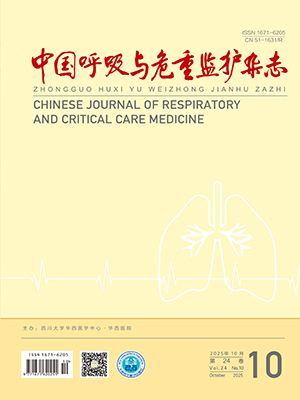| 1. |
肖泠西, 邓旺. 急性呼吸窘迫综合征主要生物标志物的研究现状及评价. 临床肺科杂志, 2023, 28(11): 1753-1757.
|
| 2. |
翁兵兵, 黄絮, 吴大玮, 等. 急性呼吸窘迫综合征早期进展与预后的关系. 中国呼吸与危重监护杂志, 2024, 23(1): 37-42.
|
| 3. |
Jabaudon M, Blondonnet R, Ware LB. Biomarkers in acute respiratory distress syndrome. Curr Opin Crit Care, 2021, 27(1): 46-54.
|
| 4. |
Pramana Witarto A, Samarta Witarto B, Er Putra AJ, et al. Serum Krebs von den Lungen-6 for Predicting the Severity of COVID-19 Lung Injury: A Systematic Review and Meta-Analysis. Iran Biomed J, 2021, 25(6): 381-389.
|
| 5. |
Ding L, Guo H, Zhang C, et al. Elevated matrix metalloproteinase-9 expression is associated with COVID-19 severity: A meta-analysis. Exp Ther Med, 2023, 26(6): 545552.
|
| 6. |
Tao Z, Jie Y, Mingru Z, et al. The Elk1/MMP-9 axis regulates E-cadherin and occludin in ventilator-induced lung injury. Respir Res, 2021, 22(1): 233-244.
|
| 7. |
梁莉荣, 陈钰, 梁勇, 等. 血清激活素A和Clara细胞分泌蛋白-16及脑钠肽水平对急性呼吸窘迫综合征患者预后预测的临床意义. 中国中西医结合急救杂志, 2023, 30(1): 26-30.
|
| 8. |
Grasselli G, Calfee CS, Camporota L, et al. ESICM guidelines on acute respiratory distress syndrome: definition, phenotyping and respiratory support strategies. Intensive Care Med, 2023, 49(7): 727-759.
|
| 9. |
Meyer NJ, Gattinoni L, Calfee CS. Acute respiratory distress syndrome. Lancet, 2021, 398(10300): 622-637.
|
| 10. |
Xu H, Sheng S, Luo W, et al. Acute respiratory distress syndrome heterogeneity and the septic ARDS subgroup. Front Immunol, 2023, 14(1): 1277161.
|
| 11. |
Li G, Yan K, Zhang W, et al. ARDS and aging: TYMS emerges as a promising biomarker and therapeutic target. Front Immunol, 2024, 15(1): 1365206.
|
| 12. |
Han L, Wang S, Ma J, et al. Expression and significance of serum KL-6 in patients with acute respiratory distress syndrome. J Thorac Dis, 2023, 15(12): 6988-6995.
|
| 13. |
Yamaya T, Hagiwara E, Baba T, et al. Serum Krebs von den Lungen-6 levels are associated with mortality and severity in patients with coronavirus disease 2019. Respir Investig, 2021, 59(5): 596-601.
|
| 14. |
Kattner S, Sutharsan S, Berger MM, et al. Serum KL-6 as a Candidate Predictor of Outcome in Patients with SARS-CoV-2 Pneumonia. J Clin Med, 2023, 12(21): 6772.
|
| 15. |
Jones TK, Reilly JP, Anderson BJ, et al. Elevated Plasma Levels of Matrix Metalloproteinase-3 and Tissue-Inhibitor of Matrix Metalloproteinases-1 Associate With Organ Dysfunction and Mortality in Sepsis. Shock, 2022, 57(1): 41-47.
|
| 16. |
Olimpio F, Carvalho J, Kaminsky V, et al. Lacticaseibacillus rhamnosus attenuates acute lung inflammation in a murine model of acute respiratory distress syndrome: Relevance to cytokines associated to STAT4/T-bet and STAT3/RORɣt. Microb Pathog, 2022, 173(Pt A): 105831.
|
| 17. |
黎秋香, 王成存, 谢五菊, 等. 血清血管生成素样蛋白4、生长分化因子15及成纤维细胞生长因子21水平对急性呼吸窘迫综合征患者病情评估及预后预测的价值. 中国呼吸与危重监护杂志, 2022, 21(7): 465-470.
|
| 18. |
王桥生, 王美求, 符晖. 脓毒症相关急性呼吸窘迫综合征短期死亡风险评分标准构建. 中国呼吸与危重监护杂志, 2022, 21(3): 162-169.
|




